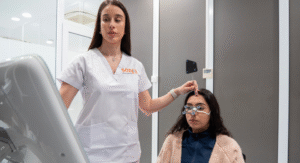Parkinson’s Awareness Month is an annual event dedicated to raising awareness about Parkinson’s disease, a progressive neurological condition that affects millions of people worldwide. Let’s take a deeper look into understanding Parkinson’s by addressing some of the most common questions surrounding the condition and exploring the role of neuromodulation as an innovative approach to managing its symptoms and improving patients’ quality of life.
What is Parkinson’s disease?
Parkinson’s disease is a neurodegenerative disorder that primarily affects movement. It occurs when nerve cells (neurons) in the brain that produce dopamine, a chemical messenger essential for smooth and coordinated muscle movements, become impaired or die. This results in a range of motor symptoms, including tremors, stiffness, slowness of movement, and impaired balance and coordination.
What causes Parkinson’s disease?
The exact cause of Parkinson’s disease remains unknown, but it is believed to involve a combination of genetic and environmental factors. Researchers have identified certain genetic mutations and environmental toxins as potential contributors to the development of the condition. However, more research is needed to fully understand its origins.
Is Parkinson’s disease hereditary?
While most cases of Parkinson’s disease are sporadic and not directly inherited, having a family history of the condition can increase an individual’s risk. Certain genetic mutations associated with Parkinson’s can be passed down from generation to generation, but inheriting these mutations does not guarantee that a person will develop the disease.
Can Parkinson’s disease be cured?
Currently, there is no cure for Parkinson’s disease. However, various treatments are available to help manage its symptoms and improve the quality of life for patients. These may include medications, physical therapy, speech therapy, and recently, neuromodulation.
What is neuromodulation, and how does it help with Parkinson’s disease?
Neuromodulation involves the use of electrical or magnetic stimulation to modulate the activity of the nervous system. In the context of Parkinson’s disease, neuromodulation techniques have shown promising results in alleviating motor symptoms and reducing medication requirements in patients who are not adequately controlled with medication alone.
Furthermore, advances in neuromodulation technologies continue to refine treatment approaches, offering personalized solutions tailored to each patient’s unique needs. Research into closed-loop systems, which adjust stimulation parameters in real-time based on neural activity, holds promise for further optimizing treatment outcomes and minimizing side effects.
As we observe Parkinson’s Awareness Month, it’s crucial to not only raise awareness about the challenges faced by individuals living with Parkinson’s disease but also to highlight the innovative therapies and treatments that offer hope for a better future. Neuromodulation, represents a valuable tool in the management of Parkinson’s symptoms, offering improved symptom control and enhanced quality of life for patients. Through ongoing research and advocacy efforts, we can continue to advance our understanding of Parkinson’s disease and work towards more effective treatments and, ultimately, a cure.




